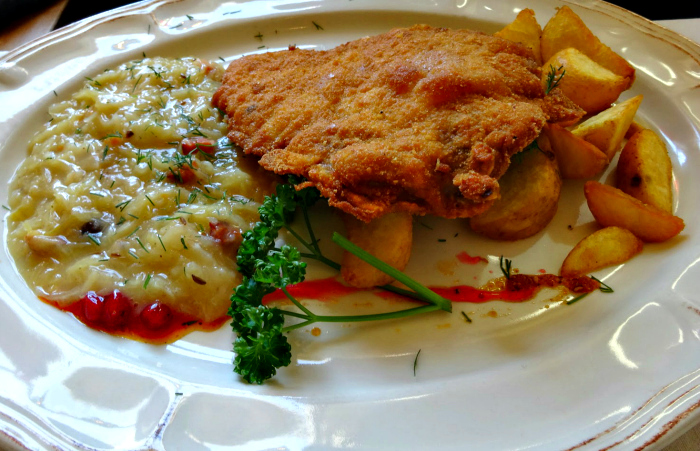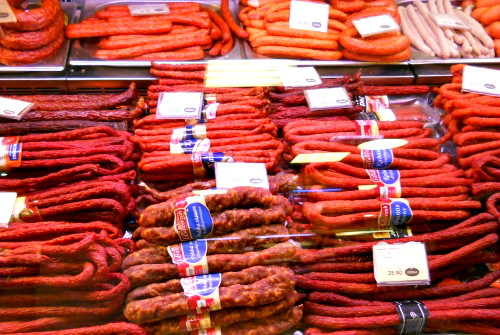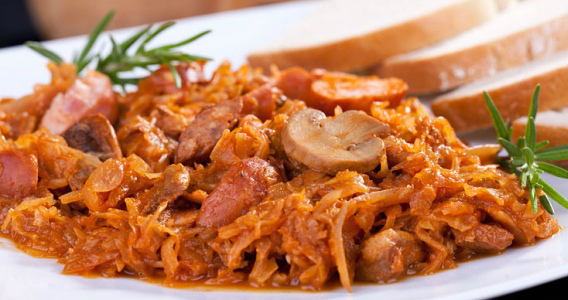Cabbages, Potatoes, and Vodka...Oh My!
At first glance, that title may evoke visions of Russia, of some fragrant, Russian stew consisting of all three ingredients (to my knowledge, there is no such stew). But those visions would be wrong. Cabbages, potatoes, and vodka are the flavors that stand out most when I remember Kraków, Poland. In all respects, except the vodka, Polish food was remarkably familiar because it reminded me so much of Hungarian cuisine.
And, incidentally, I also recall eating the most delicious incarnation of sauerkraut in all of Europe in Kraków.
Zupa Ogórkowa

Probably one of the most traditional Polish foods is cucumber soup. I'm going to be honest here; when I went to Kraków, this dish scared me, because it's usually made from sour or salted cucumbers. Pickle soup? I'd thought. No, thanks! A year later, however, I got the recipe from one of my graduate school professors, who happened to be Polish, worked up the courage to make it, and ended up liking it.
Despite the sour cucumbers, the soup is not actually sour. The cucumbers are prepped in a similar way to a Hungarian sour cucumber salad. Fresh cucumbers are sliced, diced, or shredded; are salted to pull out their liquids; and then are steeped in a vinegar-water-sugar solution. Meanwhile, potatoes are boiled, along with a bay leaf, and at the very end, the softened cucumbers are added. The cooking process, plus the potatoes and spices, mellow out any potential sourness or saltiness, leaving a cool, mild, and refreshing taste instead.
Alternatively, pickled cucumbers can be used in place of the fresh cucumbers.
Kapusta Zasmażana

Let me preface this by restating the fact that I love sauerkraut. Seriously, no one I know loves fermented cabbage more than I do. I eat it every chance I get, in whatever incarnation I can find it. And this Polish variant, eaten at Wesele restaurant in Kraków's main square, is my absolute favorite. Consisting of sauerkraut pan-fried with onions, smoked ham chunks, and lots of black pepper, kapusta zasmażana was the perfect accompaniment to my breaded, fried pork cutlet (kotlet schabowy or Wiener schnitzel) and potatoes.
Pierogi

When Americans think of Polish cuisine, pierogi are the food that most often come to mind. Simply put, they are potato dumplings, similar in construct to the Italian ravioli. Half moon-shaped pockets of unleavened dough (i.e., pasta) are filled with a variety of ingredients, including cheese, sauerkraut, onions, meats, mushrooms, mashed potatoes, or a combination of these. Served with chopped, pan-fried onions and sour cream, pierogi are utterly delicious. When Kyrie Adderholt and I went to Kraków in 2013, we shared a plate of cheese-onion-potato pierogi.
As with many foods I like, these Polish potato dumplings were originally considered peasant food, but they eventually rose in popularity and are now frequently eaten in other Slavic countries, as well.
Kotlet Schabowy

Breaded, pan-fried pork cutlet is one of the staples of Central European cooking. The Austrians and Germans have it (Wiener schnitzel), as do the Hungarians (bécsi szelet or rántott hús) and the Poles (kotlet schabowy). This is likely because pork is the most commonly consumed meat in Central and Eastern Europe and because Europeans, like Americans, do enjoy their pan-fried foods. In Kraków, kotlet schabowy is generally served with potatoes (boiled, with parsley; mashed; or pan-fried) and their sinfully good pan-fried sauerkraut, stewed green or red cabbage, or some sort of salad.
Kiełbasa

Sausage. Literally every European country has its own variant, and kiełbasa is the Polish kind. The etymology of the name is actually quite interesting. Although the word itself just means "sausage," its origins may lie in the Turkic kol basa, ("hand-pressed") or in the Hebrew kol basar ("all kinds of meat").
In Poland, as in other European countries, kiełbasa comes in many forms. It can be smoked or fresh and made from pork, beef, lamb, veal, or chicken, depending on the region. Rather conveniently, however, the most prized version comes from Małopolskie, southern Poland, which includes the city of Kraków. In fact, as the name implies, krakowska is a garlicky and peppery smoked sausage from Kraków.
Bigos

This amalgamation of fresh cabbage, sauerkraut, pork and/or beef kiełbasa, bay leaves, marjoram, black pepper, tomatoes, and mushrooms is Poland's national dish. Its origins, however, are not Polish. It is widely believed that a Lithuanian duke named Jogaila brought the stew to Poland when he became king of the country in 1385. He allegedly served it to his hunting party guests, and back then, it likely contained game meat, such as venison or rabbit, in addition to pork or beef. Thus, it is considered a hunter's stew, though the word bigos fondly means "confusion," "big mess", and "trouble". With so many ingredients, one must admit the name is fitting.
When I went to Kraków, I regrettably did not have the opportunity to try bigos, but once again, my Polish professor came to the rescue and supplied me with a recipe (her grandmother's, to be exact). So I made it, and boy, was I glad that I did. As a lover of pork, mushrooms, and cabbage in all their varieties, this "big mess" was right up my alley.
Wódka
Vodka. No, I don't mean the Poles drink it (though they most certainly do), rather that they cook with it. On our first evening in Kraków, Kyrie and I ate at the Restauracja Tradycyja in the main square, where the food was excellent. I had pork medallions (karkówka) that were stuffed with bacon--not the American kind, but the true, East-Central European pork fat that the Hungarians call szalonna. The tender pork medallions were accompanied by a juniper berry-vodka sauce that was actually the most memorable part of my meal. I've had savory beer sauces (Germans) and whiskey sauces (Irish), but never a savory Vodka sauce.






